Xerox PARC and yesterday's office of tomorrow
I recently finished reading Michael Hiltzik’s Dealers of Lightning, which I really enjoyed. It inspired me to do some more research and share the story below about Xerox’s foray into office computing in the 1970s and ’80s. If you like this post, I strongly recommend reading the book!
Why bother?
So much has changed since the primitive computers of just a few decades ago. Why bother talking about antiquated technology when we can instead talk about the latest and greatest? A few reasons:
- It’s easier to analyze a story that’s already happened than to analyze the story of the present, since we don’t know how the future will unfold. Analyzing stories of the past helps us build skills to better analyze the present and predict the future.
- It reminds us that for behind every technical concept in computing today, there are people and a story. The people are human, with all the corresponding strengths, weaknesses, trials, and tribulations. While the technology principles have evolved, the human dynamics remain much the same.
The Backdrop
The year was 1970 and Xerox had recently acquired a computer company called Scientific Data Systems. Until that point, Xerox had achieved enormous success in commercializing the photocopier, but it had no computer expertise. With an aim to build “the office of the future”, Xerox opened a new research center in Palo Alto, California called PARC (Palo Alto Research Center).
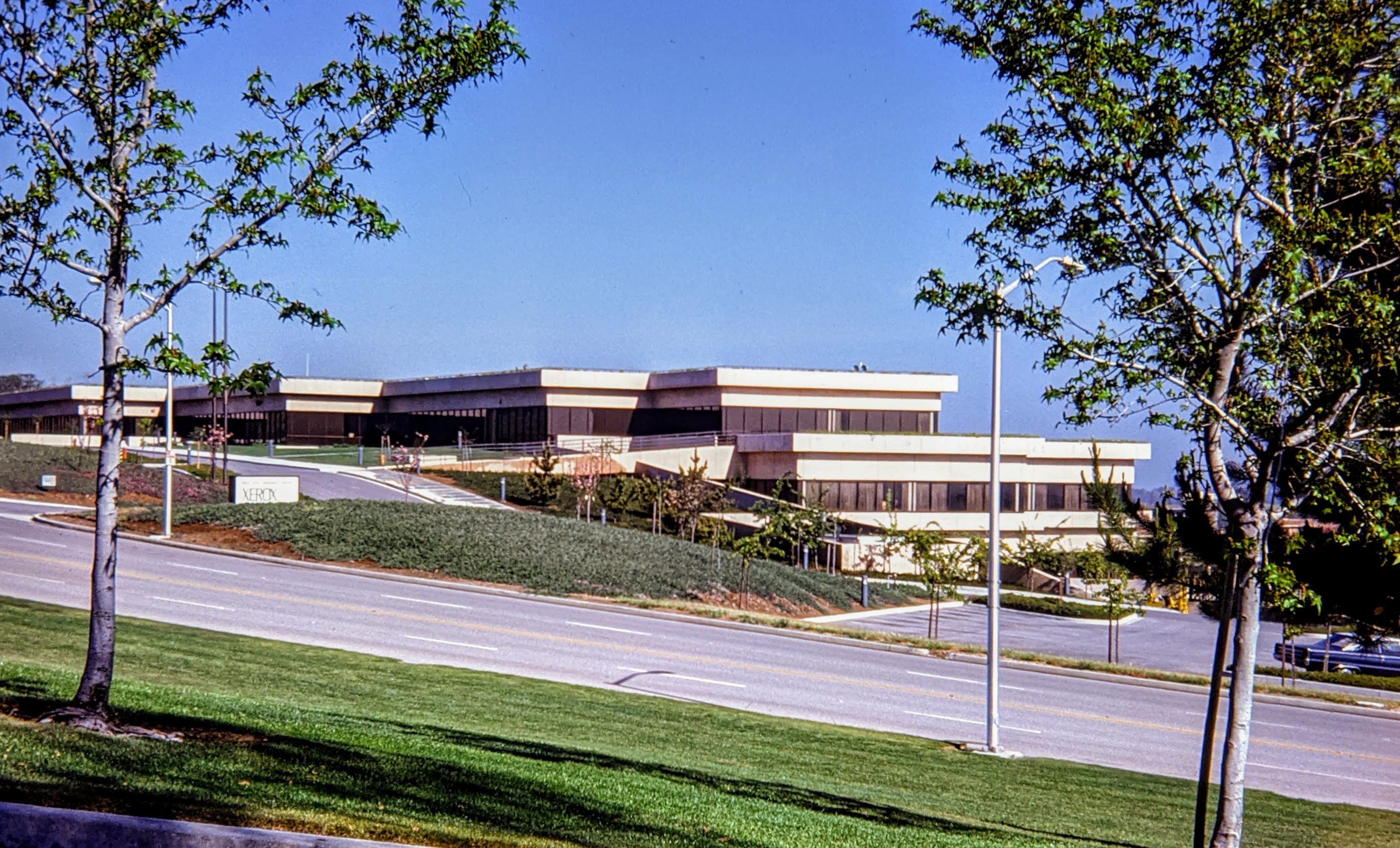
There were no personal computers on the market. Roughly speaking, computers came in two sizes: mainframe and minicomputer. Mainframes cost upwards of $100,000 (and sometimes over $1 million) and took up a good part of a room, while minicomputers were closer to the size of a refrigerator and cost over $10,000. This placed computers out of reach for the average individual, but within reach for people belonging to an institution or company that had the interest and means to buy one.
As a result, much of the focus in the industry was on time-sharing: enabling multiple people to interactively use a computer at once, giving the illusion that each user had the computer to themselves. This made sense given the massive cost of a computer — owners wanted to get the most use out of their investment. Time-sharing technology was the latest trend, following the more primitive batch processing, in which a user submitted their program into a queue for processing, a dedicated computer operator ran it on the computer hours or days later (after other programs ahead in the queue), and then finally sent the output back to the user by printout.
In time sharing systems, teletypes (paper-fed electronic typewriters) were the main input/output device, though video terminals (CRT screen + keyboard) become an increasingly popular input/output device into the later 1970s. Teletypes and video terminals both conveyed information as lines of text without graphics. Though video terminals saved paper, they were otherwise very similar to teletypes, and earned the mocking nickname “glass teletype” as a result.
PARC’s research miracle
One obvious research direction would have been to improve time-sharing technology: time-sharing was the biggest computer market at the time, and it continued to thrive through the 1970s until the introduction of the personal computer. Instead, PARC went in a different direction, driven in large part by Alan Kay’s vision for the Dynabook, “a personal computer for children of all ages.” They set out to build a computer that was different from those of the time: user-friendly, portable, and affordable. Perhaps the most important departure from the machine designs of the day was a primary focus on the display, which was to be bitmapped, meaning that each pixel could be controlled individually. This opened up endless possibilities, including rendering shapes and text in various fonts.
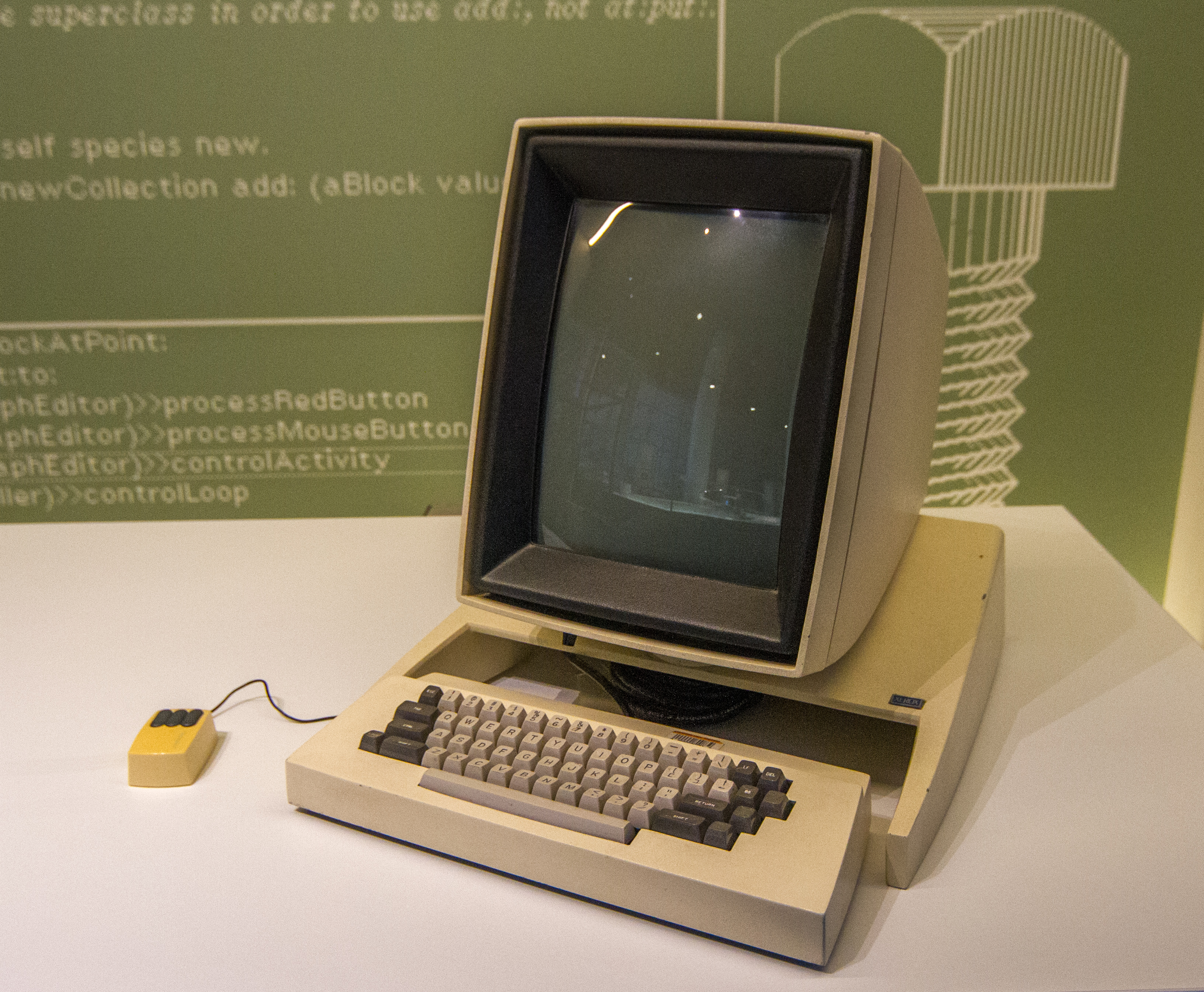
Thus the Xerox Alto was born in early 1973, sporting a 5.8MHz processor, 128KB of RAM, and a 2.5MB hard drive. It had a monochrome display sized roughly 8.5×11 inches (matching a sheet of letter-sized paper) and was controlled by a 61-key keyboard and 3-button mouse.
PARC exploded with innovation in the years that followed, achieving groundbreaking advances in both hardware and software. The Alto’s bitmapped display made possible the first graphical user interface (GUI), featuring overlapping windows, contextual menus, copy/paste, and many other ingenious features that form the foundation of today’s GUIs. The Smalltalk programming language pioneered the object-oriented paradigm, which lives on today in many of the most popular programming languages.
By the mid-1970s, PARC really did look like the office of the future: employees each got an Alto on their desk, connected to a shared Ethernet network with file servers and shared laser printers. That network, in turn, was connected to the ARPANET (precursor to the Internet) and other Xerox offices. Employees used WYSIWYG word processor software to draft documents and communicated with each other by email. Though some of these technologies (like email) existed already elsewhere, many (like the laser printer, WYSIWYG, and Ethernet) were invented at PARC and appeared there for the first time ever.
How did it happen?
PARC’s secret to success was its people. For many of its researchers, joining PARC was a natural next chapter in careers that had already been spent at the forefront of computer technology. They brought with them not just a wealth of knowledge and expertise, but also a keen sense of where computer technology had been and where it was going. Many had strong academic backgrounds, having worked on ARPA-funded university research that was groundbreaking in the field. About a dozen PARC researchers (including Butler Lampson, Chuck Thacker, and Peter Deutsch) had worked on Project Genie at UC Berkeley, producing the first time-sharing minicomputer, which was subsequently commercialized as the SDS 940. Others (like Alan Kay) did research at the University of Utah under the “fathers of computer graphics”, David Evans and Ivan Sutherland. Yet others came from such institutions as Stanford, SRI, CMU, and MIT.
Bringing all of PARC’s talented researchers together was Bob Taylor, a highly-engaged manager with profound research vision, despite not having a formal technical background in computers. Taylor enabled research to flourish at PARC by protecting it from volatility at Xerox and the industry at large. He stimulated constructive cross-team discussion through a weekly all-hands meeting called “Dealer”, in which a single person would present an idea and defend it against sharp inquiry from the room of scientists and engineers. Prior to PARC, he directed research funding at NASA and ARPA, gaining a bird’s-eye view of the most important research happening across the USA, including Douglas Engelbart’s NLS (a collaborative computer system that was astonishingly advanced for the time) and the ARPANET. In those capacities, he also established relationships with many brilliant researchers, making it easy to later recruit them into PARC. PARC also benefitted from an open-door culture and proximity to other important research centers, like Stanford University.
There was also an important element of timing, or what you might call luck. PARC was born at a confluence of important computer technology developments, including:
- The introduction of semiconductor RAM by Intel with model 1103 in 1970. Prior computers used magnetic-core memory, which took significantly more room and weight.
- The introduction of the 74181 arithmetic/logic unit (ALU) by Texas Instruments in 1970. This was the first complete ALU on a single chip, using a medium-scale integration (MSI) design. Prior computers implemented their CPUs using numerous logic gate chips across multiple boards; the 74181 replaced most of them with a single chip.
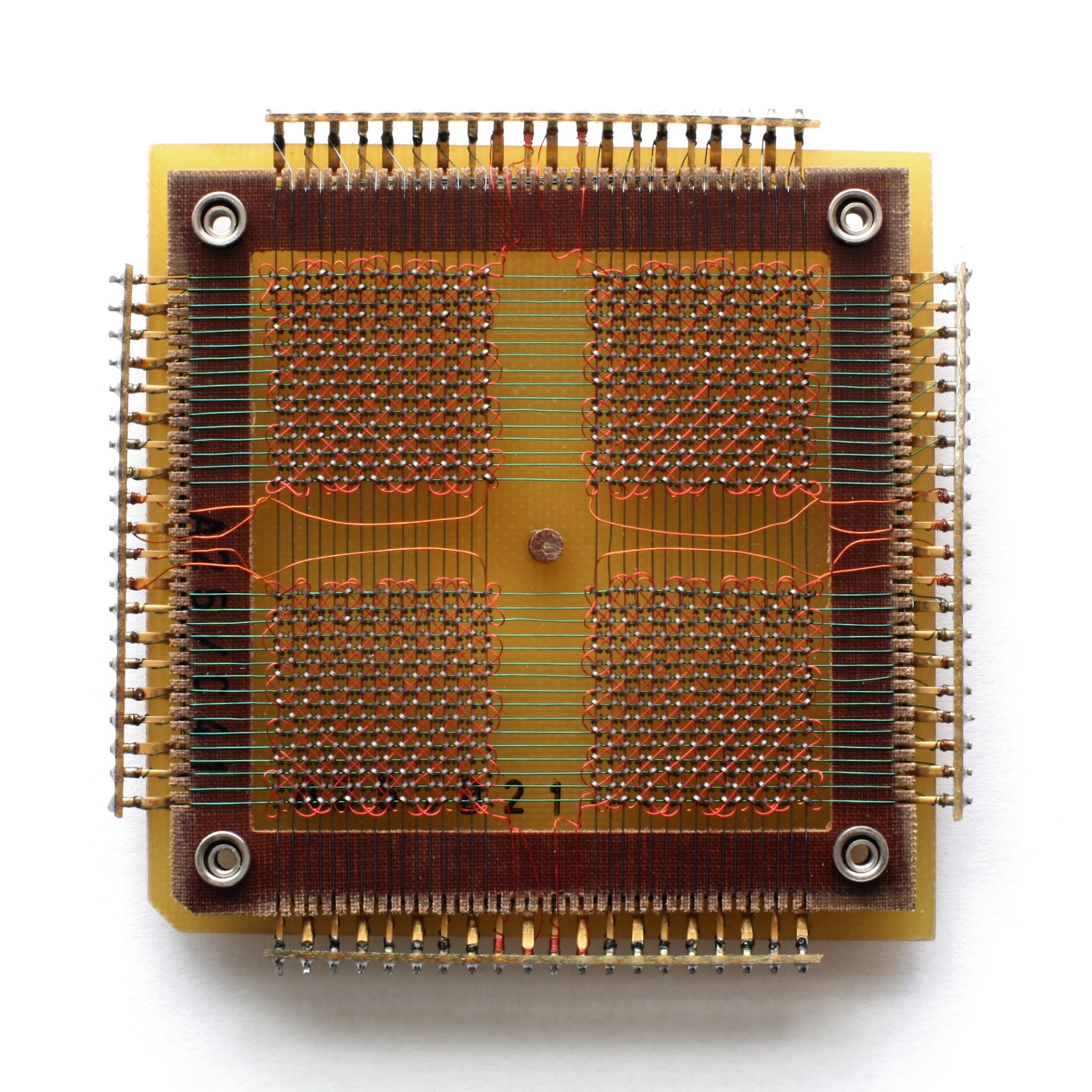
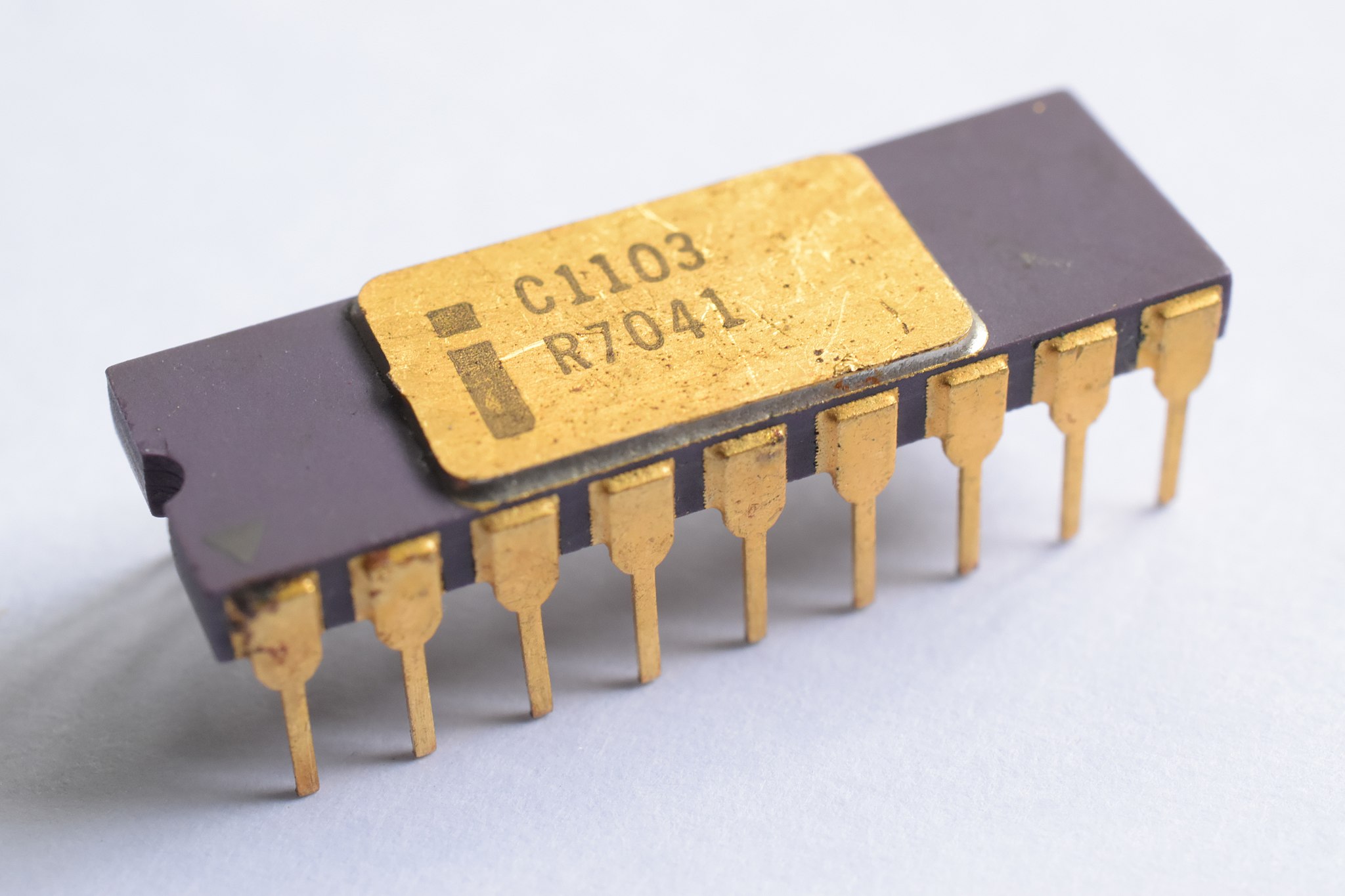
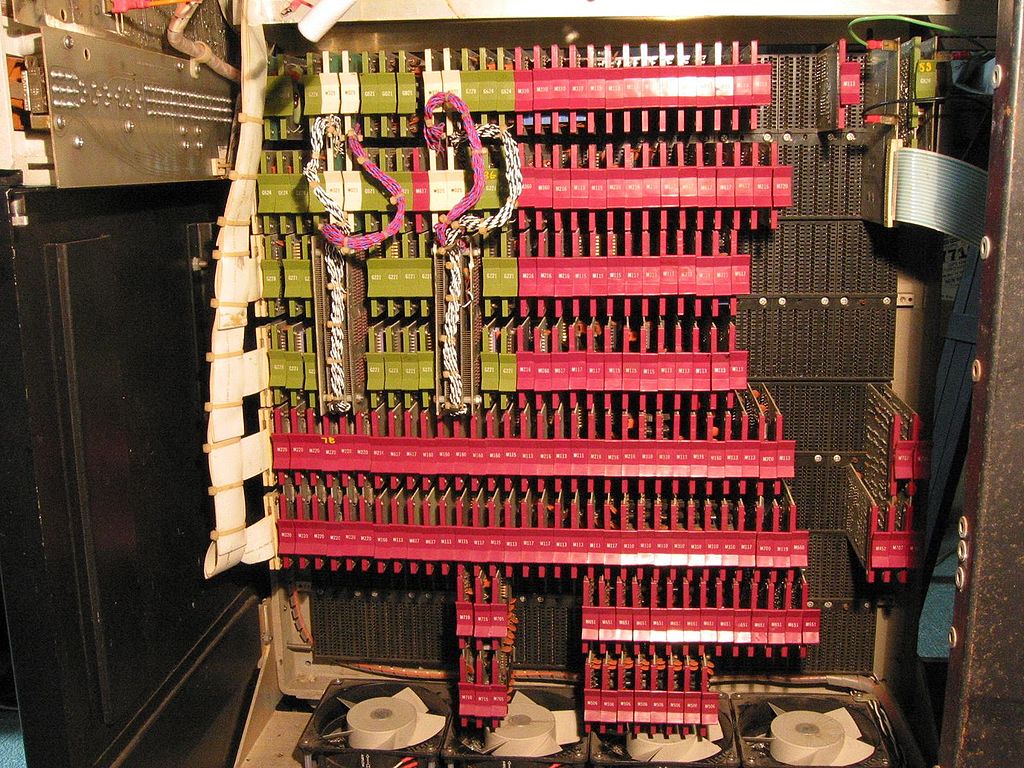
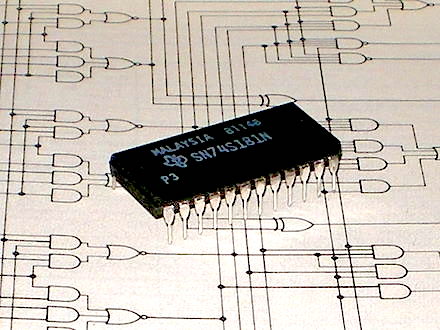
Xerox’s product disaster
PARC’s amazing research story begs, if not screams, one question: If Xerox invented the personal computer, why on earth have I never seen or used a Xerox computer?
From Alto to Star
Let’s start with a bit more history. The Alto was designed as a proof-of-concept and platform for research, not a mass-market product. PARC, being a research enterprise, was not interested in bringing the Alto to market, it was interested in exploring its full potential as a new type of machine. As a result, only about 2,000 units were ever built, and they were not generally available for sale.
Xerox, being PARC’s business-minded parent, was responsible for figuring out how to commercialize PARC’s innovations. Though the Alto’s enormous potential is obvious in hindsight, there were a few things at that time preventing Xerox from bringing it to market.
Impediments to Xerox being a PC vendor
First, selling personal computers was significantly out of alignment with Xerox’s business model. Xerox’s explosive success was thanks to the 914 copier, which it brought to market in 1959 with a unique business model. Rather than selling the machine outright, Xerox leased it to customers for a base lease rate (e.g. $95/month) plus a small fee (e.g. $0.04/page) for each copy performed with it. It was this business model, which minimized initial risk for customers, that gave Xerox whopping 41% compound annual growth for over a decade, allowing it to reach $2.5 billion in revenue by 1972. Adapting this model to selling personal computers was far from clear.
Second was that Xerox’s massive sales force, numbering about 100,000, had been trained and heavily accustomed to selling in a way that was incompatible with personal computers. Its sales strategies were built around the leasing-based model just discussed, and the salespeople did not understand how they could earn commissions selling computers. On top of that, the sales force was used to dealing with copy room managers, a different clientele than the executives, management, and professional staff to whom a personal computer would be marketed.
Third, Xerox was navigating a particularly difficult business environment in the late 1970s, including a federal antitrust investigation, fierce competition in the photocopier market, and rough economic conditions in general. Adding to this was internal strife about the company’s strategy on electronic word processing. In those days, “word processor” did not refer to a piece of software, but actually a standalone electronic office machine whose sole purpose was drafting, printing, and saving documents. Xerox had a division based in Dallas that was building these machines, which were essentially scaled down computers dedicated exclusively to drafting documents. Compared to the Alto, their functionality was limited and their hardware less sophisticated. Company politics put the Dallas division’s goals in conflict with bringing a full-fledged personal computer like the Alto to market.
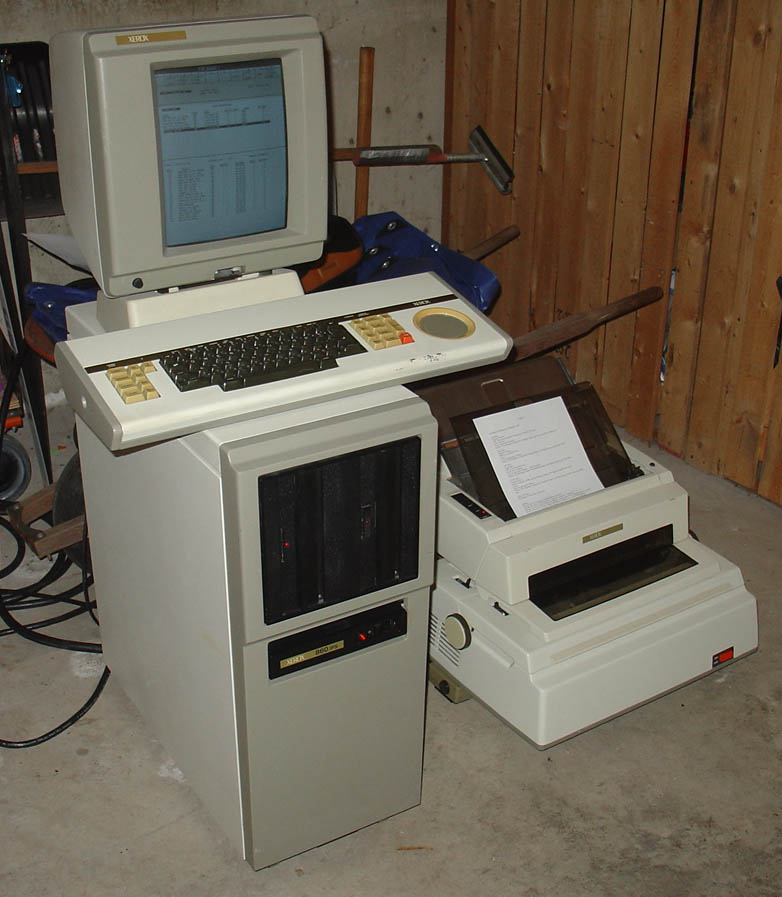
Completion, against the odds
As a result, Xerox’s strategy around personal computing was marked by ambivalence and indecision. PARC’s innovations would finally reach the market in 1981 as the Xerox Star Information System, six years after the project’s conception, and with no less than three major organizational reshufflings of the project team during that time.
Despite the organizational turbulence surrounding its development, the Star came out as much more than just a rebranded Alto — it was a revolutionary system that was far more advanced than anything else on the market. It brought numerous groundbreaking PARC inventions together in a consistent package that was sophisticated and capable, yet simple to understand and learn. It introduced significant inventions of its own, especially in GUI design, including the Desktop metaphor and object-oriented user interfaces. Its hardware was a remarkable technical achievement, matching the performance of a PDP-11 minicomputer, but at about 1/10 of the cost, and about 1/3 the size and power consumption. (A key technical decision behind this success was to forego the general purpose input/output bus present in minicomputers like the PDP-11 in favour of Ethernet.)

| Alto | Star | |
|---|---|---|
| Processor | 5.8MHz, TI 74181-based | 7MHz, AMD Am2900-based |
| RAM | 128KB | 384KB, expandable to 1.5MB |
| Hard drive | 2.5MB | 10MB (with options for 29MB and 40MB) |
| Display | 8.25”x10.5” CRT | 10.5”x 13” CRT |
| Floppy drive | None | 8” |
| Ethernet | 3 Mbit/s | 10 Mbit/s |
| Operating system | Alto Executive | Pilot |
| Purchase price | N/A (not widely sold) | $16,500 (~$50,000 in 2021 $) |
The product strategy behind Star
There were some surprising elements to the product strategy behind Star. It was not designed to be a standalone personal computer, but was instead intended as a tightly integrated multi-machine system consisting of workstations, servers, and printers. Unlike early PCs, networking (Ethernet) was a key axiom in Star’s design, and the software had many network-based features baked in from the start. Star machines were marketed as the “Xerox 8000 Series”, including the Star personal computer as the “8010 Workstation”, while “Star” itself technically referred to the software that brought the whole system together. Though the 8010 Workstation on its own cost $16,500, a complete Star system, including a few networked workstations and a Xerox laser printer, was a massive investment on the order of $250,000.
Rather than aiming for a minimum viable product (MVP), Xerox took the opposite approach — it tried to make Star so advanced and complete from the outset that it would sustain lasting market success into the next decade. Some benefits of this approach were that the GUI was extraordinarily well thought-out and consistent, and that the entire system (including different machines, hardware components, and software layers) was remarkably well-integrated. The approach’s disastrous downside was that it delayed the Star’s introduction, leaving time for competitors to join the market, and shrinking Xerox’s opportunity to later iterate and find product-market fit.
Even more baffling was that Star was a completely closed system, meaning that third parties could not develop software or hardware for it. Star’s software was monolithic: every program, from document editor, to operating system, to drawing utility, was developed by Xerox and provided together in a single package. Altogether, this meant that Star users completely lacked the ability to customize their computer by installing or removing programs. This seems bizarre judging in hindsight from our personal computing paradigm, but begins to make sense with more context. First, there was no such thing as third-party software at the time: software was either developed by the computer maker itself, or custom-built by the purchaser of the system to their specific needs (e.g. airline ticketing). This was the dominant paradigm in the mainframe and minicomputer worlds, and would have been the default for any new computer strategy. Second, Star deliberately tried to abstract away details like programs and the operating system to ease its use by non-technical office workers.
(Failure to) Launch
Star launched in April 1981 at the National Computer Conference to great excitement and interest. Seeing its mouse-driven interface, complete with windows, icons, and WYSIWYG document editing, would have been reason enough to recognize that the machine was far different from anything else on the market. That, however, turned out to be both a blessing and a curse: Star’s futuristic features were so unfamiliar that many potential customers would have had a difficult time understanding how it could be useful to them. Unfortunately, the excitement did not last long for Xerox, as Star struggled to gain traction in the market. Only about 30,000 Star workstations were ever sold, far short of the 100,000s that Xerox had envisioned.
Why did it fail?
There was indeed a very important new computer launched in 1981, but it was not the Star — it was the IBM PC, which we now know ushered in the era of personal computing. Though the PC was not nearly as sophisticated as the Star, lacking a bitmapped display, networking, and many of Star’s other most impressive features, it had one major advantage: it was almost 10x less expensive, at $2000 vs the Star’s $16,500. This was comparing the cost of each individual machine, but let’s not forget that Star was sold as a multi-machine system that could easily surpass $250,000. Star was clearly in a different category than the PC, having a different (and superior) feature set designed for a different audience. But in those early days of personal computing, many of the nuanced differences were likely lost on the average customer, who was new to computers in general. Instead, they would likely find themselves struggling to justify paying 10x the price for one personal computer over another.
For all its innovation, Star also had some flaws, the most prominent of which being its user interface’s subpar performance. Performance goals were not specified in Star’s comprehensive functional specifications, leaving performance issues unaddressed during the development process. As a result, the user interface felt sluggish during normal operation, with some processes (like saving a document) sometimes taking minutes. Though Star’s hardware was top-of-the-line for the time, it was still stretched to the limit running Star’s software, which was well ahead of its time. For comparison, Windows 3.1 (launched over a decade later) required about 3x the processor speed and 5x the RAM.
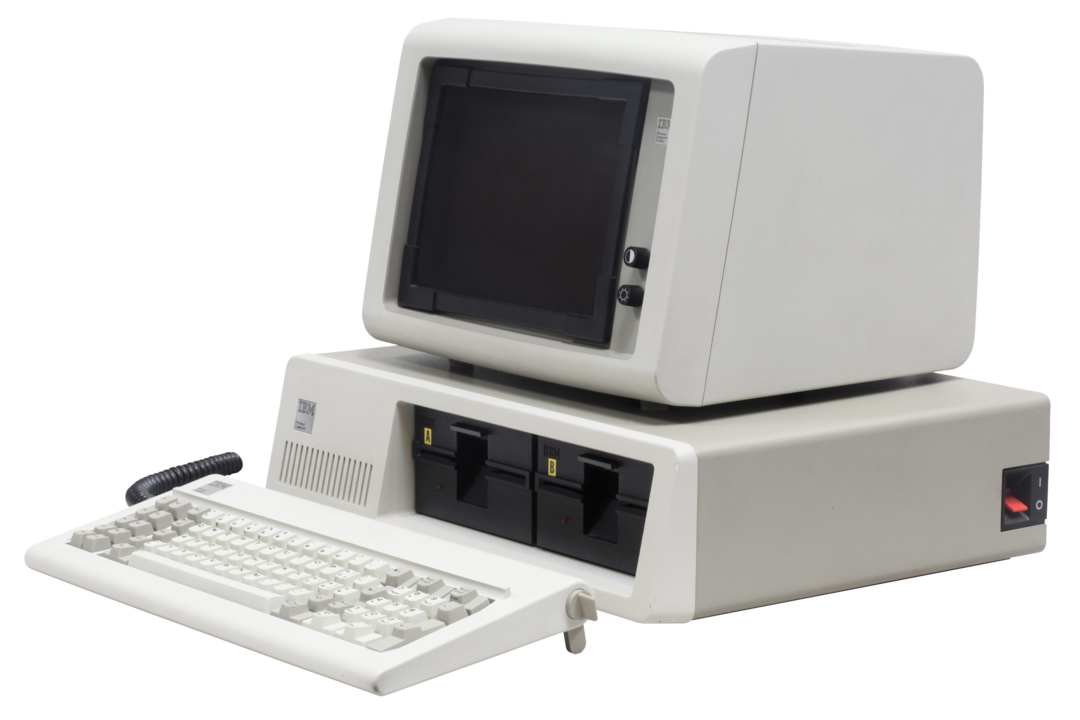
Fading into irrelevance
No sooner had Xerox entered the office computing market than had it already started fading into irrelevance. Though it followed the Star with a more powerful, less expensive iteration called the 6085 Daybreak in 1985, and later sold the Star software on its own as GlobalView, Xerox never managed to gain significant traction in the office computing space. Needless to say, most computer users today would never guess that Xerox made computers, let alone have used one.
Xerox continues to operate today, focused mainly on its copier/printer business. Valued at $3.7B, it’s considered a “mid-cap” company, paling in comparison to others that capitalized on the personal computing revolution, including Intel at $200B (54x), Microsoft at $2.3T (620x) and Apple at $2.5T (675x). PARC still exists too, now operating as an independent company owned by Xerox, and providing R&D partnership to a wide range of companies (not just Xerox).
Closing thoughts
Vertical integration and closed systems
One interesting feature of the story is the degree of vertical integration in Xerox’s computers: the CPU, graphics, networking, printing, operating system, and application software were all made in-house. This went hand-in-hand with the closed nature of the system, meaning that outsiders did not have access to the technical design and interfaces of the hardware and software. This had its pros and cons:
| Pros | Cons |
|---|---|
|
|
Contrast this approach with the IBM PC, which brought together an IBM motherboard, Intel CPU and controller chips, an operating system written by Microsoft, and application software from a variety of other vendors. The PC’s product strategy effectively sliced up the machine and outsourced each component (both hardware and software) to an individual company that could then own and optimize it. This strategy enabled clone machines, a gamut of expansion hardware, and myriad new PC software, which in turn fuelled the PC’s domination of the market. It is, no doubt, one of the key decisions behind the PC’s success to this day. That Xerox took the opposite path is certainly notable, and perhaps one of the factors in its personal computing failure.
There is, however, another computer manufacturer that took a similar approach to Xerox, building machines with strong vertical integration and a closed architecture. That company is Apple, which has also achieved radical success, illustrating that the closed vs. open architecture debate is not one-sided. Apple has proven the advantages of a strong vertically-integrated architecture, including more reliable software, fewer compatibility issues, and better hardware (the M1 SoC being a great recent example).
Destined to fail?
A sense of disappointment accompanies the story of PARC: for a company that was so ahead of the curve technologically, how did Xerox miss the opportunity to lead the personal computer revolution in the market?
First, an important distinction: the Star was never a personal computer, but rather a workstation computer. Compared to standalone personal computers, workstation computers were interconnected with other machines by LAN, bulkier, more expensive (~10x), and correspondingly marketed to higher-end customers with larger budgets. The Star’s product naming (8010 Workstation), pricing, and marketing towards serious office workers in the Fortune 500 clearly positioned it in the workstation class. Xerox’s choice to market to this high-end, high-profit market was predictable, considering that it did the same with its other products (including copiers, word processors, and fax machines).
In The Innovator’s Dilemma, Clayton Christensen observes that as companies become more established, they tend to move towards selling in the higher end of the market, where margins are bigger. On the surface, this tendency makes good business sense, as it increases profits. Looking closer, though, there’s a problem: by ignoring the low-profit, low end of the market, a company leaves that segment open to be taken by new companies. A new company can establish itself there and iteratively improve its products until they also suit the needs of the high-end market, at which point the incumbent company’s products no longer offer a competitive edge justifying their higher price. This squeezes the incumbent into a shrinking higher-end market and can eventually spell its demise, completing what Christensen calls disruptive innovation.
In the story of Star, Xerox made the classic moves of a company ripe for disruption, rather than a company leading disruption. Spoiled by high profit margins in its existing product lines, it took its revolutionary computer technology directly to the high-end workstation market, ignoring the low end of the market. Because Star did not create a new market, it would be classified in Christensen’s model as a revolutionary sustaining innovation, not a disruptive innovation. When the PC arrived just a few months later, it did create a new market, starting a process of disruption that would eventually reshape the entire market above it, including workstations, minicomputers, and even mainframes. As PCs became increasingly capable and affordable in the years to follow, the Star’s competitive advantage continued to diminish.
As Christensen points out, though, it’s rare for an established company to lead disruptive innovation, because doing so means preemptively investing in a low-end, low-margin market and enduring the pain of decreased profits and potentially cannibalized sales from the company’s own higher-end products. Instead, new entrants like startups are best suited to lead disruption because they don’t yet have an established business model, and thus have much less to lose by focusing on a low-margin market. In other words, an established player like Xerox was never likely to succeed in leading a disruptive innovation like the PC — the opportunity was much better suited to new entrants like Apple and Microsoft.
PARC as a case study in bringing R&D products to market
Xerox’s office computing story, from Alto, to Star, to irrelevance, is a great example of the challenges associated with bringing new R&D creations to market. What’s abundantly clear from the story is that a strong technological edge without a good product strategy is not enough to succeed in the marketplace.
There were many choices in Star’s product strategy that could have been different:
- Instead of introducing the complete Star product series in a “big-bang” launch 6 years after the project started, Xerox could have made incremental innovations to the Alto and mass-marketed it by the mid-late 1970s. In this scenario, Xerox could have had a personal computer in the market years before the IBM PC was launched, and gradually introduced users to new concepts of graphical computing so that they wouldn’t appear so alien in the Star.
- Instead of marketing the 8010 Workstation as part of a package deal with other expensive hardware, Xerox could have marketed it as a standalone product, and with a lower price.
- Xerox could have opened up the Star (hardware and software) for third-party expansion, enabling a wider selection of Star software (and potentially hardware too), and in turn increasing its utility and appeal.
Xerox’s short-lived, but seminal, computing tradition
Looking back, Xerox’s personal computing legacy is a profusion of ideas and inventions, but not products. Xerox inventions like copy/paste, WYSIWYG, and Ethernet are ubiquitous in computers today, but the Xerox brand itself is absent, replaced by Microsoft, Apple, and others.
Xerox missed out, of course, on the opportunity to profit massively from those ideas and inventions. But on a deeper level, it missed the opportunity to shape personal computing according to its unique tradition. The brilliant minds at PARC lucidly envisioned a computer that turned the complex and arcane into something simple and fun. The Star’s user interface, even from today’s perspective, was remarkably simple and consistent, considering its sophisticated feature set. Some would argue that its design remained better than any other commercial offering even a decade later.
What might the personal computer be like today had Xerox’s foray into selling office computers been successful? We can only imagine…